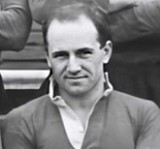Llanelli is the foremost town in Carmarthenshire, dwarfing in size the county town of Carmarthen due to its rapid expansion following the industrial revolution. With an ever-growing influx of workers and their families, to work in the numerous coalmines, steelworks and tinplate works, Llanelli became a thriving sporting community. The most famous nowadays is the famous Llanelli Scarlets Rugby Club, but its parent club, Llanelli RFC, was the original team in the town. The Club was first established by Mr John D. Rogers, a young industrialist who had played rugby union football at Rugby School, the birthplace of the game. He was assisted by Mr C. Hilton as honorary secretary, and they gathered around them a group of young men to form the first club in 1872. The neighbouring town of Swansea formed its own club in 1875, whilst Neath RFC had formed in 1871, and these three clubs became the original three first-class clubs in Wales. People’s Park in Llanelli was used for training, while the team wore a kit of dark blue jerseys. In September 1879 the Club announced that it had secured rights to play at the Stradey cricket ground and played its first official match there against Neath on 29 November that year. The team colours changed to rose and primrose stripes in 1882, then the following year changed to reed with chocolate quarters, however the famous Scarlet jersey made its first appearance on 14 April 1884, thus beginning the legendary Scarlets rugby side. Several former Scarlets players fell during the great war, whilst many other served and returned home safely, some of whom earning gallantry awards during the conflict. I do not know if there is an existing war memorial to the former Scarlets players, but I have taken the opportunity to add this page to the website, and also to add details of known notable football players and members of other Llanelli and rugby teams who fell during the war, as they all appear to have been closely interlinked with the Scarlets.
I have also been made aware by an avid rugby historian, Keith Bowen, of two former Scarlets who ‘Went North’ to play Rugby League for Wigan and who fell during the war, so have added the details these men below. Keith’s father, Jackie Bowen, himself played alongside these men with the Scarlets, before joining them to head north to Wigan.
If anyone knows of anyone else missing from this page, I would be grateful for details.
The Great War, 1914-1918
Albert Didymus Beynon, Private, 13165, Royal Welsh Fusiliers. Albert was born in 1886, the son of Evan Beynon and Margaret Ann Beynon (nee Jones), of 72, Pembrey Road, Llanelli. He was a fine athlete, having played full back for the Scarlets prior to the war and he was also an accomplished cricketer and boxer. Albert worked as a labourer prior to the war. He enlisted at Llanelli into the 9th Battalion, Royal Welsh Fusiliers soon after the outbreak of war. The battalion had formed at Wrexham in September 1914, before moving to Tidworth to join 58 Brigade, 19th (Western) Division. On 19 July 1915 Evan landed in France with the battalion, and the entire 19th Division then moved to the Nursery Sector at Calonne for trench initiation alongside the Dehra Dun Brigade. The infantry battalions of the division then began carrying out the usual routines of rotating in the trenches: four days in the front line; four in support; and four in reserve, interspersed with training regimes and carrying out working parties and trench raids. Just south, the British launched a great offensive around the town of Loos on 25 September 1915, and the 19th Division was ordered to attack from its positions at the same time, to attempt to draw enemy attention away from the main battle area. The attacking battalions of the 19th Division were in place by 04.00, and then at 05.50 the men climbed out of their trenches to launch their assault, behind a gas and smoke screen. The assault was a disaster, and heavy casualties were suffered by the 19th Division for no gain. Albert had been killed in action during the attack that day, struck by shrapnel in the head. The 28-year-old has no known grave and is commemorated on the Loos Memorial, France. Probate was granted to Mary Annie Davies, the mother of his illegitimate child, Christopher.
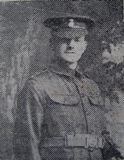
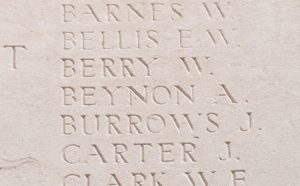
Robert George Davies, Private, 14142, South Wales Borderers. Robert was the son of William and Catherine Davies, of 38, Island Place, Llanelli. He worked as a tinplate riser and was a well-known Llanelli rugby player. Robert enlisted at Llanelli into the 4th Battalion, South Wales Borderers soon after the outbreak of war. The battalion formed at Brecon, before moving to Park House Camp, near Tidworth to join 40 Brigade, 13th (Western) Division, then moved to billets in Cirencester before moving to Woking in March 1915 for final training. On 29 June 1915 the Division sailed from Avonmouth for Mudros, before landing at Cape Helles, Gallipoli on 15 July 1915. Two weeks later the Division was moved to Anzac, to reinforce the Australian and New Zealand troops there, in readiness for a great assault on the Sari Bair Ridge, in conjunction with fresh Allied landings at Suvla Bay. The assault began on 6 August 1915 and raged over the coming days. The 4th SWB reached the Achyl Dere before assaulting, and seizing Damakjelik Bair, one of the ridges held by the Turks. The Turks counter-attacked on 9 August and terrible fighting raged throughout the day. Robert was killed here four days later, on 13 August 1915. The 32-year-old is buried in Hill 60 Cemetery, Gallipoli.
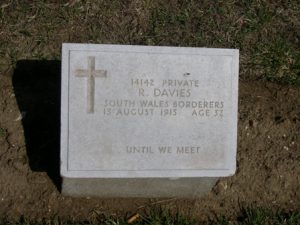
Ebenezer Morgan Downing, Private, 12024, Royal Welsh Fusiliers. Ebenezer was born in 1888, the son of Thomas Henry Downing and Margaret Downing (nee Morgan), of Prospect Place, Llanelli. He worked as a blacksmith prior to the war and had played rugby at forward for the Scarlets and New Dock Stars for several years. Ebenezer enlisted at Llanelli into the 8th Battalion, Royal Welsh Fusiliers soon after the outbreak of war. The battalion had formed at Wrexham in August, joining 40 Brigade, 13th (Western) Division on Salisbury Plain, then moved to Chiseldon in billets. During February 1915 the division moved to Blackdown to complete its training before embarking for the Mediterranean in July 1915 and then sailed from Mudros for Gallipoli, landing at Cape Helles from 16 July. The division was withdrawn back to Mudros at the end of the month before landing at Anzac Cove on 4 August to take part in the great Anzac offensive which opened on 8 August. Following heavy casualties at Gallipoli, the campaign was closed down and the 13th Division was evacuated to Egypt on 8 January 1916, concentrating at Port Said, where it held forward posts in the Suez Canal defences. On 12 February 1916 the Division began to move to Mesopotamia, to strengthen the force being assembled for the relief of the besieged garrison at Kut al Amara. By 27 March, the Division had assembled near Sheikh Saad and came under orders of the Tigris Corps, and then took part in the attempts to relieve Kut. However, after these efforts failed and Kut fell, the British force in the theatre was built up and reorganised. The Division then fought at the Battle of Kut al Amara, then at the capture of the Hai Salient and the capture of Dahra Bend. They took part in the passage of the Diyala, in the pursuit of the enemy towards Baghdad, and part of the Division were the first British troops to enter Baghdad after it fell on 11 March 1917. Ebenezer survived the war but had suffered several bouts of malaria and after being demobilised on 19 January 1919 his health deteriorated quickly. He died of malaria in Llanelli General Hospital on 4 August 1919, aged 31. Ebenezer is not commemorated by the CWGC. A brother, Glyn Downing, also played for the Scarlets.
Arthur Evans, Private, 156259, Machine Gun Corps. Arthur was born in 1889, the son of James Evans and Lucy Evans (nee Walters), of 68, Alban Road, Llanelli. He worked as a furnaceman at the South Wales Tinplate Works prior to the war and was a highly regarded player for the Oriental Stars Rugby Team at Llanelli. Arthur originally enlisted into the South Wales Borderers in 1916 and served in France with the regiment before being sent home suffering from trench fever and spent over four months recovering at Epsom Hospital. Upon his recovery he was drafted back out to France in the summer of 1918, joining the 3rd Battalion, Machine Gun Corps, which was attached to the 3rd Division. On 21 August 1918 the Allies launched a huge offensive from the Somme Sector and began driving the Germans back towards the mighty Hindenburg Line. The 3rd Division was in positions at Fouquereuil, south of Bethune, and moved to Camblain-Chatelaine before entraining for Warlincourt and marched to Monchy Au Bois before joining the great offensive, advancing through Mory on 12 September. Arthur was killed in action near Ribecourt, during the fighting around the Canal Du Nord, on 6 October 1918. The 28-year-old is buried in Ribecourt British Cemetery, France.
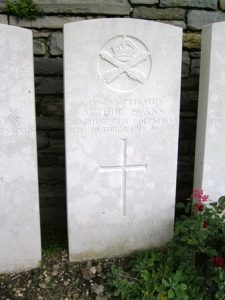
Alcwyn Morland Gibson, Second Lieutenant, West Yorkshire Regiment. Alcwyn was born in 1896, the son of George Gibson and Sarah Jane Gibson (nee Jones), of Dock House, Llanelli. His mother died when he was just two years old, so his father moved back with Alcwyn to his parents’ home at 58, Alban Road, Llanelli. Alcwyn was educated at the Llanelli Intermediate School. He had played several games at forward for the Scarlets prior to the war and was also a talented footballer and cricketer. Alcwyn was articled to Mr Leslie Williams, Solicitor at Llanelli, but left his position to enlist into the 1/28th Battalion, London Regiment, the Artists Rifles. From there Alcwyn was commissioned as Second Lieutenant into the 7th Battalion, West Yorkshire Regiment on 11 July 1916. After a brief spell home on leave, Alcwyn was drafted to France in August 1916, and was posted to the 1/6th Battalion, West Yorkshire Regiment, which was attached to 146 Brigade, 49th (West Riding) Division. The division had suffered heavy casualties whilst assaulting Thiepval Ridge on the opening day of the Somme offensive, capturing the Leipzig Salient. After a long spell in the line, the 1/6th West York’s had a brief rest before taking part in another costly assault near Authille on 3 September. Alcwyn joined the battalion at Forceville, where the men were undertaking a brief spell of rest and company training prior to going back into the line again, taking over positions at Paisley Avenue on 21 September. Alcwyn was killed in action during an assault on Thiepval village on 27 September 1916. The 20-year-old has no known grave and is commemorated on the Thiepval Memorial, France.
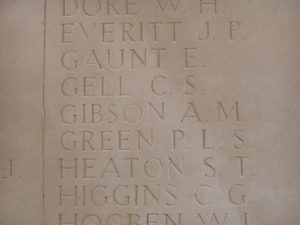
Harry Percy Bright Gough, MC & Bar, Major, Welsh Regiment. Harry was born at Llanelli on 18 January 1880, the son of Frederick George Gough and Sarah Ann Gough (nee Bright). Henry was educated at Llandovery College and trained as a schoolteacher. He played rugby at half-back both for Llanelli and for the Vale of Lune RFC at Lancaster whilst working in the city as a schoolteacher as a young man. Harry married Martha Reid Fullerton in Dublin in 1912, and the couple had two children over the coming years. He must have taught in London at some time after this, when he played rugby for London Welsh RFC, but at the outbreak of war, Henry was Science Master at Oakham Grammar School, in Rutland. He left his post to enlist in the 14th (Swansea) Battalion, Welsh Regiment soon after the outbreak of war. In 1915 Henry was commissioned as Second Lieutenant and was posted to the 17th Battalion, Welsh Regiment. He was then promoted to Captain, at the time of the Battalion’s departure for France in July 1916. The Battalion was attached to 119 Brigade, 40th (Bantam) Division, and moved to the front near Loos. Late in 1916 the division moved south to the Somme, taking part in the Battle of the Ancre, and remained in the area over the winter. In March 1917 the Germans withdrew to their shortened line, called the Hindenburg Line, and the 40th Division was one of the Divisions that followed the withdrawal. Henry distinguished himself in a successful action south of La Vacquerie on 18 May 1917, when a trench raid resulted in the capture of an enemy machine-gun and two unwounded prisoners, at no loss of life to his own men. For his part in the operation, Henry was awarded the Military Cross. During the autumn of 1917, his Battalion was in support of the 12th SWB and 19th RWF in the attempt to capture the stronghold of Bourlon Wood, during the Battle of Cambrai and suffered heavy casualties, losing 17 officers and 301 other ranks. Henry then found himself in command of the severely depleted Battalion. He was awarded a Bar to his Military Cross for his actions here, however, by this time the 17th Welsh had virtually ceased to exist. The Division was caught up in heavy fighting during the spring of 1918, during the German Offensive on the Lys. Henry was sent to command a section of the East Surrey Regiment, which was defending a support trench system running north to south through Strazeele, but on 22 April 1918 was severely wounded, and died at the 62nd London Casualty Clearing Station that same day. The 38-year-old is buried in Arneke British Cemetery, France. His son, Henry Hugh Gough, was killed in Malta in 1942.
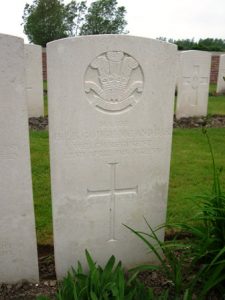
Thomas Pryce Hamer, Lieutenant, South Wales Borderers. Thomas was born in 1883, the son of Edward Hamer and Emily Hamer (nee Matthews), of Summerfield Park, Llanidloes. He was a local celebrity prior to the war, and played association football for Llanelli for two seasons, and had represented Wales at international level, as well as being a wealthy industrialist. Thomas was commissioned as Second Lieutenant into the South Wales Borderers on 1 April 1915, and was posted to the 11th Battalion, South Wales Borderers. The battalion was at Colwyn Bay attached to the 43rd (Welsh) Division. The Division trained in North Wales before moving to Winchester in the summer of 1915, where the formation became renumbered 115 Brigade, 38th (Welsh) Division. The Division began moving to France on 2 December 1915 and moved to the Nursery Sector near Fleurbaix for trench initiation alongside the Guards Division. The Division then held a sector of the line near Cuinchy before marching south to the Somme sector in June 1916 to take part in the assault on Mametz Wood. The first attack on Mametz Wood was launched on a two-battalion front on 7 July 1916, with the 16th Welsh attacking from the slope facing the wood, with the 11th South Wales Borderers in support and the 10th South Wales Borderers in reserve. The men launched their assault at 08.30 behind a poorly placed artillery barrage and immediately came under heavy machine-gun fire from Mametz Wood and enfilade Fire from Flatiron Copse and Sabot Copse. The 16th Welsh had suffered terrible losses and the survivors were forced to retire with over 280 men killed, wounded or missing, whilst the 11th SWB had suffered 129 casualties. Thomas, acting as battalion Adjutant, was initially reported as wounded, but he had been killed in the wood that day. The 33-year-old has no known grave and is commemorated on the Thiepval Memorial, France. As a result of this initial failed attack on Mametz Wood, the divisional commander, Sir Ivor Philipps, was swiftly replaced and the division made a second, successful, attack three days later, almost clearing the wood before being relieved on 12 July.
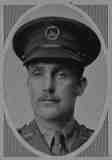
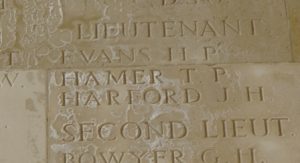
William Joseph Harland, Private, 13668, Welsh Regiment. William was born in 1880, the son of Marshal Harland and Caroline Harland (nee Williams), of New Buildings, Long Row, Llanelli. He had played rugby for the Scarlets at forward prior to the war. William enlisted at Llanelli into the 9th Battalion, Welsh Regiment soon after the outbreak of war. The battalion had formed at Cardiff in September 1915, moving to Salisbury Plain to join 58 Brigade, 19th (Western) Division. The battalion embarked for France with the division on 18 July 1915, and the division moved to positions north of Loos in the Givenchy area, to begin trench initiation and training. The division then took part in a very costly diversionary attack here on 25 September 1915, intending to draw German attention away from the main assault at Loos. The Division remained in Flanders until being relieved at the end of April 1916 and moved into the rear areas around Flesselles for training, then in the middle of June moved into the Somme sector, near Albert, where it took part in the second wave of the attack on Ovillers-La Boiselle on 2 July, capturing the village at heavy cost and remained in the line for several days before being relieved. After a brief rest the 19th Division then moved into the shattered remains of Mametz Wood on 21 July, in readiness for another assault, moving into positions at Bazentin-le-Petit on 23 July, in support of the 9th RWF. The men worked hard over the coming days, digging new communication trenches, in terrible conditions. William was killed in action here during a particularly heavy German artillery barrage which hit the battalion on 24 July 1916. The 36-year-old has no known grave and is commemorated on the Thiepval Memorial, France. His brother James was killed in France two years later, whilst another brother, Thomas, died in 1925 as a result of illness contracted during the war.
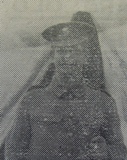
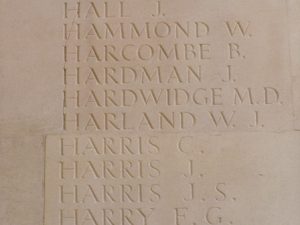
Brinley Joshua Howells, Private, PS/6278, Royal Fusiliers. Brinley was born in 1890, the son of John Howells and Esther Howells (nee Davies), of Lynholme, 14, Glenalla Road, Llanelli. He was educated at Llanelli Grammar School, prior to becoming a schoolteacher. Brinley was a highly regarded rugby player who also excelled in tennis. He moved to Abertridwr prior to the war, where he worked as a schoolmaster at Senghenydd, and enlisted there into the Royal Fusiliers. Brinley was posted to the 21st Battalion, Royal Fusiliers, which was known as the 4th Public Schools battalion, and was attached to 19 Brigade, 33rd Division. (The members of the battalion were later known as the Chocolate Soldiers by members of the 2nd RWF in the same Brigade, due to the amount of goods sent to them by loved ones back home). The battalion embarked for France at Folkestone aboard the SS Princess Victoria on 14 November 1915 and disembarked at Calais, then entrained for Boulogne, before the entire division moved to positions near Bethune, taking over trenches near Beuvry. The Division endured a hard time during its first few months in the line, holding such notorious sectors as Cambrin and Cuinchy, where underground warfare was prevalent. Brinley was killed in action here during a routine spell in the trenches on 8 February 1916. The 26-year-old was buried in Cambrin Churchyard Extension, France.
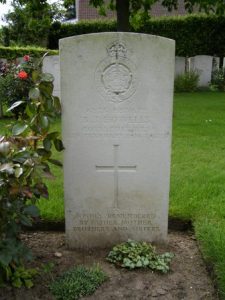
Llewellyn Howells, Private, 260389, Gloucestershire Regiment. Llewellyn was born in 1898, the son of John Howells and Mary Ann Howells (nee Jones), of 16, Biddulph Street, New Dock, Llanelli. He played for the Machynis Rugby Club prior to the war. Llewellyn worked as an annealer at the South Wales Tinplate Works prior to enlisting at Llanelli into the Monmouthshire Regiment. Upon being drafted to France in the summer of 1916, Llewellyn was posted to the 12th (Bristol) Battalion, Gloucestershire Regiment, which was attached to 95 Brigade, 5th Division. The division saw heavy fighting during the Somme offensive, taking part in the fighting at High Wood, Guillemont, Flers-Courcelette, Morval and Le Transloy. On 5 October 1916, after suffering heavy casualties, the Division moved to Festubert, where it remained until March 1917, when it was relieved and moved to the Arras Sector, to prepare for the forthcoming Battle of Arras. The division took part in much fighting here over the coming months, before being relieved on 7 September 1917, and moved north to join the great offensive in Flanders. The division took over positions in Sanctuary Wood by 6 October and the 12th Gloucester’s were busied on trench repairs and carrying duties, often under heavy artillery fire. Llewellyn was killed here by another artillery bombardment on 10 October 1917. The 18-year-old is buried in Hooge Crater Cemetery, Belgium.
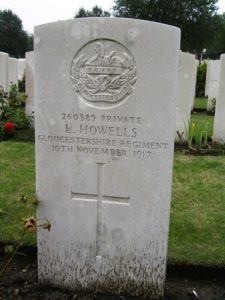
Daniel Jones, Gunner, 97887, Royal Field Artillery. Daniel was the son of David Jones and Mary Jones, of 23, Pemberton Street, Llanelli. He worked as a furnaceman at the South Wales Tinplate Works, and lodged with his sister, Mrs Elizabeth John, at 12, Vittoria Street, Llanelli. Daniel had played rugby for the Black Watch and Albion teams and had made several appearances at forward for the Scarlets. He enlisted at Llanelli into the Royal Field Artillery soon after the outbreak of war. He embarked for France on 9 July 1915 and joined A Battery, 45th Brigade, Royal Field Artillery. The battery was attached to the 8th Division and had been on the Western Front since October 1914. Daniel joined the battery at Fromelles and took part in his first major action during the Action of Bois Grenier on 25 September 1915, when the division made a diversionary attack, intending to draw German attention away from the main offensive at Loos. The division fought throughout the Somme offensive the following year, then in March 1917 followed the German withdrawal to the Hindenburg Line. Later that year the division moved to Ypres, fighting at the Battle of Pilckem Ridge, and the Battle of Langemarck. When the Germans launched the first phase of their great offensive on 21 March 1918, the Division was situated facing the Hindenburg Line near Vaux Wood and met the German Offensive head on, before being driven back together with the rest of the line. Daniel was killed during heavy fighting near Gouzeaucourt on 4 April 1918, whilst his battery was firing at German targets around the town. The 32-year-old has no known grave and is commemorated on the Pozières Memorial, France.
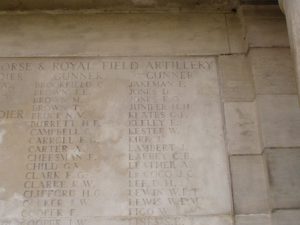
Evan Jones, Sapper, 448158, Royal Engineers. Evan was born at Llangendeirne in 1887, the son of John Jones and Margaret Jones. He trained as a tailor before moving to Llanelli to set up his own business, and after marrying Mary Charles Harries in 1910, the couple initially settled at Llanegwad, Brynallt Terrace, Llanelli, before moving to 31, Ralph Terrace, Llanelli. Evan had played rugby at forward for the Llanelli Tuesdays Rugby team prior to the war. He had enlisted at Llanelli into the Welsh Field Company, Royal Engineers soon after the outbreak of war. The company was attached to the 53rd (Welsh) Division and embarked for the Mediterranean in July 1915, before landing at Gallipoli on 8 August, taking part in heavy fighting over the coming days. Evan had returned home at some time after, either through wounds or sickness, and upon recovering was drafted to France, joining the 9th Division Signal Company, Royal Engineers. In March 1918 the 9th Division was in the Cambrai area and was one of the Divisions hit there by the German Spring Offensive, seeing heavy fighting at the Battle of St Quentin. Evan was wounded during the terrible fighting which ensued, suffering multiple gunshot wounds to his legs, and died in a Casualty Clearing Station on 11 April 1918. The 31-year-old is buried in Arneke British Cemetery, France. His brother, Ivor Sidney Jones, had been killed at Mametz Wood in 1916.

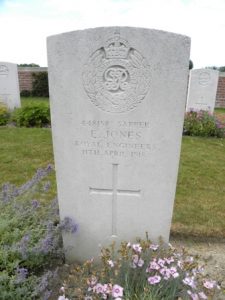
Henry Paul Mainwaring Jones, Lieutenant, Machine Gun Corps. Henry was born on 18 May 1896, the son of Harry Jones and Emily Margaret Jones (nee Mainwaring), of 29, Half Moon Lane, Herne Hill, London. His parents were both from Llanelli. Henry was educated at Dulwich and had gained a scholarship to study languages at Balliol College, Oxford, but instead enlisted into the army, gaining a commission as Second Lieutenant into the Army Service Corps on 15 April 1915. He served with the 9th Cavalry Brigade in France from June 1915, before transferring to the Tank Corps in February 1917. He saw his first action with the Tank Corps during the Battle of Arras, and moved with his unit to Ypres in June 1917, in readiness for supporting the planned infantry assault on the opening day of the Third Battle of Ypres. Henry was killed in action during the opening day of the battle, on 31 July 1917, aged 21. He has no known grave and is commemorated on the Ypres (Menin Gate) Memorial, Belgium. A series of his letters home were published in a book after his death, entitled “War Letters of a Public School Boy’. Although Henry never lived in Llanelli, nor played rugby for any of the town’s teams, he was a renowned rugby player, playing for the Dulwich College XV for three seasons and was made captain in his final year there.
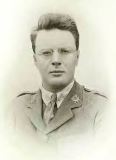
Frederick Knibbs, Lance Corporal, 13086, Royal Welsh Fusiliers. Frederick was born on 15 April 1889, the son of Frederick Knibbs and Sarah Knibbs (nee Pearson), of 30, Rock Hill, Chipping Norton, Oxon. He first came to Wales in 1907 whilst working for the Great Western Railway at Llanhilleth, but then left to work at the Batchelor’s De-Tinning Works at Llanelli. Frederick was a skilled footballer, who had played for Llanelli Town. He enlisted there soon after the outbreak of war into the 9th Battalion, Royal Welsh Fusiliers. The battalion had formed at Wrexham in September 1914, before moving to Tidworth to join 58 Brigade, 19th (Western) Division. On 19 July 1915 Evan landed in France with the battalion, and the entire 19th Division then moved to the Nursery Sector at Calonne for trench initiation alongside the Dehra Dun Brigade. The infantry battalions of the division then began carrying out the usual routines of rotating in the trenches: four days in the front line; four in support; and four in reserve, interspersed with training regimes and carrying out working parties and trench raids. Just south, the British launched a great offensive around the town of Loos on 25 September 1915, and the 19th Division was ordered to attack from its positions at the same time, to attempt to draw enemy attention away from the main battle area. The attacking battalions of the 19th Division were in place by 04.00, and then at 05.50 the men climbed out of their trenches to launch their assault, behind a gas and smoke screen. The assault was a disaster, and heavy casualties were suffered by the 19th Division for no gain. Frederick was wounded during the assault and was evacuated to the 2nd Canadian General Hospital at Le Treport, where he died of his wounds on 28 September 1915. The 26-year-old is buried in Le Treport Military Cemetery, France.
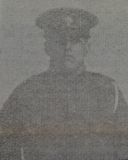
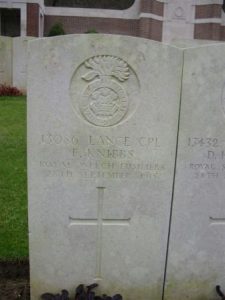
Frederick James Lewis, Private, 201636, South Wales Borderers. Frederick was born in 1894, the son of John Perkin Lewis and Mary Jane Lewis (nee Barney), of 4, Andrew Street, Llanelli. His parents were both from Pembrokeshire, but his father had come to the town to work in the tinplate works. Frederick was a regular member of the Llanelli Albion’s Rugby Team prior to the war. He enlisted at Brecon into the Brecknockshire Battalion, South Wales Borderers, and was posted to India to join the 1/1st Brecknocks, which were on garrison duties at Mhow, attached to the 5th (Mhow) Division. Frederick became ill and died in hospital at Mhow of influenza on 22 October 1918. The 25-year-old was buried in Mhow British Cemetery, but is also commemorated on the Kirkee 1914-1918 Memorial, India.
Isaac Lewis, Private, 12678, South Wales Borderers. Isaac was born in 1876, the son of David Lewis and Sarah Lewis, of Pwll Tramway, Pembrey. He had been a regular player for the Scarlets, making many appearances at forward prior to the war. Isaac had married Priscilla Morgan in 1901 and the couple had four children over the coming years, but Priscilla sadly died in 1911. His two daughters were then raised by family at Pwll, whilst Isaac kept his two sons with him. He worked as a coalminer prior to the war, but almost immediately left his work to enlist at Llanelli into the 4th Battalion, South Wales Borderers, which was attached to the 40th Brigade, 13th (Western) Division. On 13 June 1915 the Division sailed for the Mediterranean, and during July 1915 landed on Cape Helles, relieving the 29th Division, before moving to ANZAC Cove from 3 August 1915, taking part in the Battles of Sari Bair, Russell’s Top, and Hill 60, ANZAC. Soon afterwards the Division was transferred from ANZAC to Suvla Bay, and it was evacuated from Suvla on 19 December 1915, transferring to Helles. Isaac was evacuated from Gallipoli at some time and returned home to Britain. Upon recovering he was drafted to France, joining the 1st Battalion, South Wales Borderers, which was in the Loos Sector, attached to 3 Brigade, 1st Division. The Division had been in the Loos Sector since taking part in the Battle of Loos the previous year. On 29 June 1916, the 1st SWB were in reserve at Petit Sains. Isaac was attached to D Company, which was in billets in the village, when a large German shell hit the building, killing Isaac and wounding several others. The 40-year-old was buried in Bully-Grenay Communal Cemetery, British Extension, France. Soon after his death, in October 1916 a charity match was played at Stradey between Llanelli and Tumble to raise funds for his orphaned children.
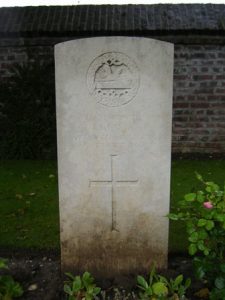
Albert Vincent Lloyd, Sapper, 20358, Royal Engineers. Albert was born on 15 September 1884, the son of Thomas Vincent Lloyd and Martha Jane Lloyd (nee Wells) of the Swansea Castle Inn, Llanelli. He had made several appearances for the Llanelli 2nds and was a renowned boxer. Albert resided at Cardiff prior to the war and enlisted there into the Royal Engineers. He embarked for France on 20 November 1914 and upon his arrival was posted to the 5th Field Company, Royal Engineers, which was attached to the 2nd Division. The division had suffered terrible casualties during its vital actions during the defence of Ypres the previous weeks and had just moved to new positions near Outtersteene to rebuild, then at the end of December the 1st Division took up new positions in the line at Festubert, a wet marshy area. On Christmas Day the men were in the trenches, cold and wet, when they were presented with their Princess Mary gift tins, which contained cards and gifts on behalf of the Royal Family. The line was relatively quiet over this period, but the trenches were flooded and in a terrible state. Nonetheless, the division remained in the line here over the coming months, concentrating on the never-ending work of repairing and consolidating trenches. The 1st Division took part in a desperate defensive action here on 25 January 1915 the Germans hit their lines with an intensive artillery bombardment, before launching an infantry assault, breaking through 100 yards of trench and reaching Givenchy village. Heavy fighting raged throughout the day as the Germans were driven back and the line regained. The division then took part in the abortive Battle of Aubers Ridge, before moving into the Loos Sector. On 1 September 1915 Albert was disposing of dozens of captured German hand grenades by throwing them into a canal, when one exploded in his hand, taking off his hand and badly injuring him. He was evacuated to the 1st Casualty Clearing Station but died soon afterwards that same day. The 32-year-old is buried in Chocques Military Cemetery, France.
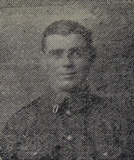
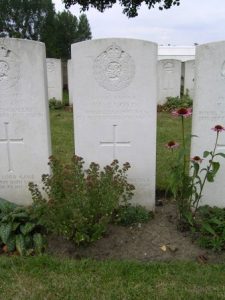
William Ivor Lloyd, Private, 7607, South African Infantry. William was born in 1880, the son of Richard Morgan Lloyd and Caroline Sophia Lloyd (nee Hall), of 20, Woodfield Street, Llanelli. He had played rugby at Full Back for the Scarlets prior to emigrating to South Africa in 1901, following the end of the Boer War. William enlisted in Transvaal into the 3rd Regiment, South African Infantry. After its formation, the 3rd Regiment embarked at Cape Town and sailed for Britain, then assembled at Bordon Camp in Hampshire. Here the South Africans began three months of training in preparation for embarking for France however, their orders were changed and on 30 December 1915 they boarded ships in Devonport and sailed for Egypt to join the campaign against the Senussi tribesmen. William came home to Llanelli on leave in January 1916, his first time there in fifteen years, and caught up with a good friend, another ex-Scarlet, Ben Davies. The 3rd Regiment was then transferred to France as part of the 1st South African Brigade to join the 9th (Scottish) Division, joining the division on the Somme. The division took part in the fighting to clear the village of Longueval, before launching an assault on the adjacent Delville Wood on 15 July 1916. William was wounded during the terrible fighting in Delville Wood and was evacuated to the casualty clearing station at Corbie, where he died of his wounds on 18 July 1916. The 36-year-old is buried in La Neuville British Cemetery, Corbie, France.
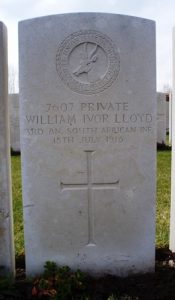
Albert Wilfred Mason, Private, 14131, South Wales Borderers. Albert was born on 30 September 1884, the son of James Edwin Mason, and Ann Mason, of 14, Cambrian Place, Llanelli. He married Elizabeth Ann Taylor at Llanelli on 1 September 1907 and the couple set up home at 34, Stepney Place, Llanelli. Albert worked as a galvaniser and was a well-known sportsman prior to the war, having played at Full Back for Llanelli RFC before playing professionally for Salford. Albert enlisted at Llanelli into the South Wales Borderers in September 1914, and was posted to the 4th Battalion, South Wales Borderers, which was attached to 40 Brigade, 13th (Western) Division. Albert was discharged from the army as medically unfit on 28 May 1915, after being diagnosed with phthisis, and suffering from chest pains. His medical records show that the 4th SWB had been billeted in terrible conditions, and that this had brought about Albert’s illness. Albert returned to Llanelli where he died on 22 December 1916, aged 32. Albert’s case was put forward by me to the CWGC on 4 August 2013 but was rejected on 22 July 2014 as it is thought that the medical cases do not tie up. An appeal was then put in by, but after further deliberation he was again rejected. His brother David James Mason also fell, killed in Egypt in 1917.
William Bertram Protheroe, Lieutenant, Royal Flying Corps. William was born in Garnant in 1891, the son of William Henry Protheroe and Elizabeth Protheroe (nee Morgan). The family then moved to Delfan, Gilbert Crescent, Llanelli soon after his birth as his father had set up his own boot store. William was employed by Thomas & Clement prior to the war and was a highly regarded rugby player. He enlisted into the army soon after the outbreak of war and was commissioned as Second Lieutenant into the 15th Battalion, Welsh Regiment, the Carmarthen Pals battalion, on 3 April 1915. He landed in France with elements of the battalion on 4 December 1915 and served with the battalion until after the fighting at Mametz Wood, when he volunteered for service with the Royal Flying Corps. William gained his Pilots wings, and was promoted to Lieutenant, joining 53 Squadron, RFC in France. At 02.20 on the morning of 12 June 1917, William and his Observer, Lieutenant W. Turnbull, were flying a Photographic Reconnaissance mission over Oostaverne in their FE2b, Serial A4207, when they were spotted by Vzfw Wittekind of Jasta 28, which was commanded by Ritter Max Von Muller. The FE2b was easily outmanoeuvred by the superior German Albatross fighter, and was shot down in flames, killing both men. The bodies of William and his Observer were burnt in the wreckage, and they are commemorated on the Arras Flying Services Memorial, France. Turnbull was also a keen rugby player and reportedly an international, although no evidence of this can be found.
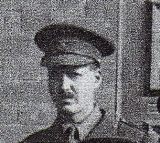
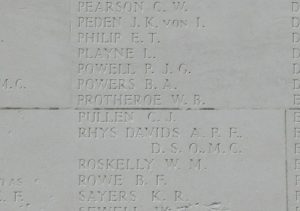
Iorwerth Cynon Roberts, Second Lieutenant, Machine Gun Corps. Iorwerth was born in 1884, the son of Edward Roberts and Margaret Roberts (nee Phillips), of Felinfoel. He married Mary Elizabeth Jones in 1908, and the couple resided at 1, Birden Terrace, Felinfoel, where they raised two daughters. Iorwerth had been a regular player at half-back for the Llanelli 2nd team prior to becoming a school teacher at the Ffaldau Boys School at Pontycymmer prior to the war. He was commissioned as Second Lieutenant into the Machine Gun Corps in the summer of 1917 and was drafted to France at the end of the year. Iorwerth was then posted to the 25th Battalion, Machine Gun Corps following its formation from the Machine Gun Companies of the 25 Division at the end of February 1918. The new battalion remained attached to the 25th Division and was in the Achiet-le-Petit area. At dawn on 21 March 1918 the Germans attacked along a stretch of the Western Front running south from Croisilles to La Fère and broke through the lines in several places. Under extreme pressure, the British rushed reinforcements to the area, which included the 25th Division which was ordered to take up positions near the Bapaume to Cambrai Road. The 25th Battalion, MGC took part in desperate fighting over the coming days, losing almost fifty of its 64 guns. The division was then relieved and moved to the quieter Wulverghem area to rest and rebuild, and Iorwerth took over command of the newly reformed A Company. On 9 April 1918 the Germans launched the second phase of their great offensive along the Lys Valley, smashing through the area held by the Portuguese near Port Arthur crossroads. The 25th Division was thrown into action once again, being caught up in heavy fighting around Ploegsteert. Iorwerth was killed in action here on 10 April 1918, during a day of desperate fighting. The 33-year-old has no known grave, and is commemorated on the Ploegsteert Memorial, Belgium.
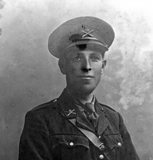
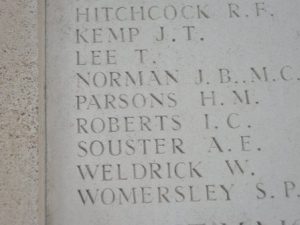
Victor George Roberts, Second Lieutenant, Welsh Regiment. Victor was born in 1897, the son of Joseph Roberts and Annie Roberts (nee Bowen), of Y Goedwig, Lakefield Road, Llanelli. He had been a Welsh schoolboy rugby international before beginning to play in the backs for the Scarlets. Victor joined the Inns of Court OTC on 2 January 1916 and was commissioned Second Lieutenant into the 4th Battalion, Welsh Regiment on 28 February 1917. Victor was drafted to France and was posted to the 15th Battalion, Welsh Regiment, the Carmarthen Pals battalion, which was at Ypres attached to 114 Brigade, 38th (Welsh) Division. The division had taken over the Canal Bank sector at Boesinghe the previous year, following its assault on Mametz Wood. The infantry battalions of the Division then began carrying out the normal pattern of rotation in the trenches, four days in the front, four in support and four in reserve, whilst also working on trench improvement, digging new trenches, and also carrying out regular patrols and trench raids. The Third Battle of Ypres was due to open on 31 July 1917 and in the days leading up to the battle, the 15th Welsh were holding positions in the Zwaanhof sector. At 17.00 on 27 July 1917, two platoons from the 15th Welsh were sent out to check the German positions. They found no Germans in the front line, but their support and reserve positions were strongly held, and here the patrols met with strong opposition and were forced to hurriedly withdraw. The Germans retaliated to this by hitting the front-line trenches with an artillery barrage, mixing up some gas shells into the bombardment for good effect, and the battalion suffered heavy casualties as a result, with the war diary showing figures of three officers and twenty-one other ranks killed, three officers and sixty-one other ranks wounded, and a further thirteen men missing. Victor was among the officers killed that day. The 20-year-old is buried alongside many of his comrades in Bard Cottage Cemetery, Boesinghe, Belgium. His elder brother, William John Roberts, had played at outside half for the Scarlets.
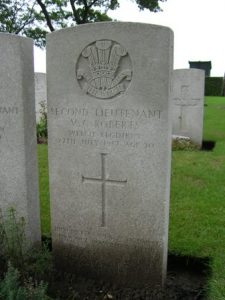
Hume Buckley Roderick, Captain, Welsh Guards. Hume was born on 17 June 1887, the eldest son of Lieutenant-Colonel William Buckley Roderick and Ella Augusta May Roderick (nee Nicholl), of Goodig, Pembrey. He was educated at Parkfield School, Hayward’s Heath, and at Rugby, where he was a member of the Cricket XI. Hume later qualified as a Solicitor and became a member of the firm of Roderick and Richards, at Llanelli. He had played for the Scarlets at three-quarter for six seasons prior to the war. Hume was already serving as an officer with the 4th Battalion, Welsh Regiment when war broke out. The battalion was the local Territorial unit and mobilised for war at Carmarthen in August 1914, as part of South Wales Brigade, Welsh Division and moved to Tunbridge Wells until the end of the month, before moving to Scotland to man the Forth and Tay Defences. On 17 April 1915 the battalion moved to Bedford, joining 158 Brigade, 53rd (Welsh) Division. On 19 July 1915 the entire Division sailed from Devonport for Imbros and on 9 August 1915 landed at Suvla Bay. The infantry moved off the beaches across the Salt Lake, under shellfire, into the scrub covered Chocolate Hill, but due to a lack of maps and no knowledge of the terrain, many of the units became disorientated, and the situation became chaotic. After the terrible fighting, the Gallipoli battlefront calmed down and winter set in. Hume took ill in the terrible conditions which ensued and after a brief spell in hospital in Malta was invalided home due to laryngitis. Hume then returned to Egypt to re-join the 4th Welsh in 1916, but later that year returned home again, to take up a Commission in the Welsh Guards. Whilst back home on leave on 9 November 1916, he married Frances Mary Barbara Garnons-Williams, the daughter of the late Lieutenant-Colonel R. D. Garnons-Williams, who had been killed at Loos the previous year. The couple set up home at Tegfan, Devynock, Breconshire. Hume joined his new Battalion on the Western Front in December 1916 and took command of No. 3 Company, 1st Battalion, Welsh Guards. In July 1917 Hume was wounded at Ypres, but remained at the front, and moved with the Battalion from Ypres to positions near Cambrai, where they fought at the Battle of Cambrai throughout November and December 1917. Hume was killed in action at Cambrai on 1 December 1917, whilst leading his Platoon on a charge against a German Machine Gun Post. The 30-year-old is buried in Gouzeaucourt New British Cemetery, France. His brothers Alan Whitlock Nichol Roderick and John Victor Tweed Roderick were also killed during the war. Another brother, William Buckley Nichol Roderick, had also played for the Scarlets prior to the war.
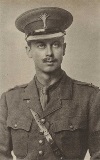
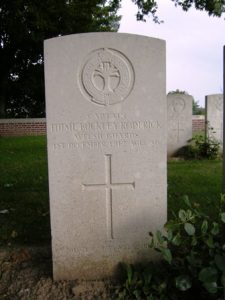
James Roscoe Samuel, Second Lieutenant, North Staffordshire Regiment. James was born in 1893, the son of James Samuel and Elizabeth Samuel (nee Price), of 4, Coldstream Street, Llanelli. James was educated at Llanelli Intermediate School and had played rugby and cricket for the school. His father, a former professional soldier, died on 10 May 1915. James followed in his footsteps and enlisted into the King’s Shropshire Light Infantry, serving in the ranks before being commissioned as Second Lieutenant into the North Staffordshire Regiment. He was then drafted to Mesopotamia on 4 July 1916, where he joined the 7th Battalion, North Staffordshire Regiment, which was attached to 39 Brigade, 13th (Western) Division. The British had sent a large force to Mesopotamia in the spring of 1916 to secure the oilfields and also to relieve the besieged troops of General Townshend at Kut. This heralded the opening of a theatre of war that was to see more casualties suffered by sickness and disease than in action. James was killed in action in Mesopotamia just after the Second Battle of Kut, on 25 January 1917. The 24-year-old is buried at Amara War Cemetery, Iraq.
George Edward Scott, Private, 3016, Welsh Regiment. George was born at Bristol in 1892, the son of John Scott and Mary Ann Scott (nee Lovell). By 1901 the family had moved to 4, Bank Buildings, Llandeilo, where George and his brothers and sisters were educated. George and his brother John had played rugby for Llandeilo. By the outbreak of war, the family had moved to 37, Victoria Street, Llandovery. George worked as a mason and following his marriage to Janet Jones at Llandovery on 22 August 1913 the couple moved to 16, Mansel Street, Pembrey. George then began playing rugby at full-back for the Scarlets. He returned home and enlisted at Llandovery into the 1/4th Battalion, Welsh Regiment soon after the outbreak of war. The battalion was the local Territorial unit and mobilised for war at Carmarthen in August 1914, as part of South Wales Brigade, Welsh Division and moved to Tunbridge Wells until the end of the month, before moving to Scotland to man the Forth and Tay Defences. On 17 April 1915 the battalion moved to Bedford, joining 158 Brigade, 53rd (Welsh) Division. On 19 July 1915 the entire Division sailed from Devonport for Imbros and on 9 August 1915 landed at Suvla Bay. The infantry moved off the beaches across the Salt Lake, under shellfire, into the scrub covered Chocolate Hill, but due to a lack of maps and no knowledge of the terrain, many of the units became disorientated, and the situation became chaotic. George was wounded soon after and was evacuated to a Hospital Ship anchored offshore, where he died of his wounds at sea on 14 August 1915. The 23-year-old was buried at sea, so is commemorated on the Helles Memorial, Gallipoli. His brother John had been killed just three days earlier, whilst their father John drowned on active service at Port Talbot.
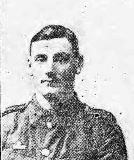
Philip Dudley Waller, Lieutenant, South African Infantry. Philip was born in Somerset on 28 January 1889, the son of Alfred Percy Waller and Emily Elizabeth Waller (nee Chard). The family had moved to 5, Greenfield Terrace, Llanelli by 1901 and Philip’s father worked as an Inspector for HM Inland Revenue. Philip began his rugby career in Llanelli and became a famous Welsh International rugby player prior to the war. Having then played hooker for Newport, he had won six caps for Wales before war touring South Africa with the British Lions in 1910 and opted to stay in South Africa. When war erupted, he enlisted into the South African forces and gained a commission as Second Lieutenant into the 71st Siege Battery, South African Heavy Artillery. After their formation, the South African Brigade embarked at Cape Town and sailed for Britain, assembling at Bordon Camp in Hampshire. Here the South Africans began three months of training in preparation for embarking for France however, their orders were changed and on 30 December 1915 they boarded ships in Devonport and sailed for Egypt to join the campaign against the Senussi tribesmen. The 1st South African Brigade was then transferred to France early in 1916 to join the 9th (Scottish) Division, joining the division on the Somme. The division took part in the fighting to clear the village of Longueval, before launching an assault on the adjacent Delville Wood on 15 July 1916, where it suffered terrible casualties. By the spring of 1917 the 9th Division was at Arras, where it fought at the First Battle of the Scarpe and the Third Battle of the Scarpe. The Division then moved north to Ypres, and fought at the Battle of the Menin Road, and at the First Battle of Passchendaele, before being moved to Cambrai, and fighting at the Action of Welsh Ridge. Philip was wounded at Cambrai and died of his wounds on 14 December 1917. The 28-year-old is buried is Red Cross Corner Cemetery, Beugny, France. His brother Richard Percy Waller was killed in a flying accident at Montrose on 23 May 1918 whilst training as a pilot.
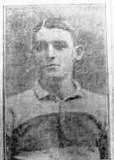
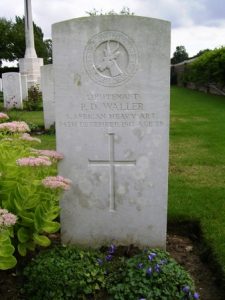
Rupert Washer, Acting Corporal, 201158, Welsh Regiment. Rupert was born at St Clears in 1884, the son of Henry Washer and Anna Washer (nee John) The family later moved to 20, Wellfield Terrace, Llanelli by 1891. Rupert worked as a tinplater and had played rugby for New Dock Stars, captaining the side for several seasons. He married Mary Hannah Rogers in 1910 and moved in with Mary and her parents at 9, Biddulph Street, New Dock. Rupert enlisted at Llanelli into the 1/4th Battalion, Welsh Regiment soon after the outbreak of war. The battalion was the local Territorial unit and mobilised for war at Carmarthen in August 1914, as part of South Wales Brigade, Welsh Division and moved to Tunbridge Wells until the end of the month, before moving to Scotland to man the Forth and Tay Defences. In December the Division moved to Cambridge and then in May 1915 to Bedford, where the Division was numbered and the formation became 158 Brigade, 53rd (Welsh) Division. On 19 July 1915 the entire Division sailed from Devonport for Imbros and on 9 August 1915 landed at Suvla Bay. The infantry moved off the beaches across the Salt Lake, under shellfire, into the scrub covered Chocolate Hill, but due to a lack of maps and no knowledge of the terrain, many of the units became disorientated, and the situation became chaotic. Rupert had been killed in action at sometime during the day, on 26 March 1917. The 32-year-old has no known grave and is commemorated on the Jerusalem Memorial, Israel.
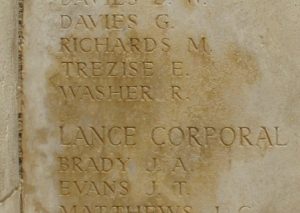
Joseph Weyman, Private, 8184, Welsh Regiment. Joseph was born on 3 December 1885, the youngest son of Daniel Weyman and Anne Weyman (nee Evans), of 7, Tovey Square, Blaenavon. His father was originally from Frocester, near Stroud, but had moved to Blaenavon to gain work as a labourer. His mother, Anne, died three in 1889, so by 1891 Joseph had been sent to the workhouse and was living at Caerleon Industrial School. In 1904 Joseph enlisted at Cwmbran into the 24th Foot (3rd Battalion, South Wales Borderers) Militia, but on 22 March 1904 re-enlisted into the Welsh Regiment at Pontypool and was posted to Cardiff. He served for three years with the 1st Battalion, Welsh Regiment, before leaving the army on 21 March 1907 and by 1911 was lodging at 128, Old Castle Road, Llanelli, where he worked as a tinplate worker and was playing at centre for the Scarlets. He was in fact a member of the Llanelli team which caused a furore during a particularly hard-fought game against Newport RFC in July 1910, when the Llanelli club were forced to take Newport to court in a libel case, following several accusations of foul play during a match the previous season. Among the Newport players who made allegations against the Llanelli side was the renowned international forward Charlie Pritchard, who would go on to be killed during the war. Joseph himself had allegations against him that he kicked his opposite number, Llewelyn Partridge, during the game, which he strongly denied! As a former soldier, Joseph was an Army Reservist, so as soon as war erupted, he was mobilised and joined the ranks of the 2nd Battalion, Welsh Regiment, together with his brother John Edward Weyman. The battalion entrained for the south coast within days of war breaking out and on 13 August 1914 landed in France. The battalion was attached to 3 Brigade, 1st Division and entrained for the Belgian frontier, near the town of Mons. The Division then took part in the Battle of Mons on 23 August, following the German invasion of the low countries, and in the epic withdrawal from Mons to the River Marne, where the German drive on Paris was halted. The Germans then withdrew north and took up defensive positions north of the river Aisne, along the Chemin des Dames Ridge and the BEF advanced before launching a frontal attack upon the German positions, seeing heavy fighting at Chivy Ridge. Joseph was wounded during the fighting on the Aisne and on 10 October was invalided back to Britain, joining the 3rd Battalion, Welsh Regiment upon recovery. Joseph was drafted back out to France and transferred to the 9th Battalion, Welsh Regiment on 16 December 1915. The 9th Welsh was attached to 58 Brigade, 19th (Western) Division, and was in the Loos Sector. The following year the Division moved to the Somme, where it took part in the second wave of the attack on Ovillers-La Boiselle on 1 July, capturing the village at heavy cost. It then fought through the Somme Battles of Poziéres and the Ancre in 1916. Joseph had survived all of these terrible battles, but his health had now broken down, and he was posted back home to the 3rd Battalion, Welsh Regiment at Ripon in December 1916. Joseph was then found to have contracted tuberculosis. He was discharged from the army as medically unfit on 14 August 1917 and returned home to live with his father, who was by then residing at 3, Foundry Row, Cwmbran. His health continued to wane over the coming years, and he eventually died of tuberculosis at Green Court, Henllys, Cwmbran, on 14 March 1919. The 32-year-old was buried in Cwmbran Cemetery.
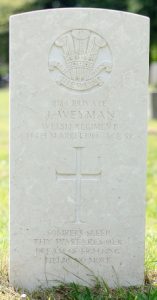
William Henry Williams, MM, Private, 14682, South Wales Borderers. William was born in 1882, the son of William Williams and Susan Williams, of 34, Custom House Bank, Llanelli. By 1911 William was living with his parents at 1, Union Cottages, Sea Side, Llanelli. He worked as a shunter on the Mynydd Mawr Railway prior to the war and had played for many years with the Llanelli Harbour Lights RFC. William enlisted at Llanelli into the 5th Battalion, South Wales Borderers early in 1916. The battalion formed at Brecon in September 1914, before moving to Park House Camp, near Tidworth to join 58 Brigade, 19th (Western) Division. In December 1914 the battalion moved to Basingstoke in billets, then on 10 January 1915 became converted to the Pioneer Battalion for the 19th Division. The Division completed its training at Bulford and Perham Down, before embarking for France and landing at Le Havre on 16 July 1915. The entire 19th Division then moved to the Nursery Sector at Calonne for trench initiation alongside the Dehra Dun Brigade. The infantry battalions of the division then began carrying out the usual routines of rotating in the trenches: four days in the front line; four in support; and four in reserve, interspersed with training regimes and carrying out working parties and trench raids. Just south, the British launched a great offensive around the town of Loos on 25 September 1915, and the 19th Division was ordered to attack from its positions at the same time, to attempt to draw enemy attention away from the main battle area. The assault was a disaster, and heavy casualties were suffered by the 19th Division for no gain. The following year the Division moved to the Somme, where it took part in the second wave of the attack on Ovillers-La Boiselle on 1 July, capturing the village at heavy cost. It then fought through the Somme Battles of Pozieres and the Ancre in 1916. William had been awarded the Military Medal for bravery in the field on the Somme, and had returned home on a week’s special leave, but was killed just four weeks later, at the Battle of Pozières, on 30 July 1916. The 34-year-old has no known grave and is commemorated on the Thiepval Memorial, France.
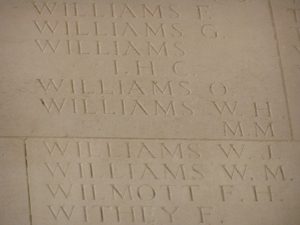
World War Two, 1939-1945
John Gwynfor Jeffreys, Lance Corporal, 2737920, Welsh Guards. John was the son of William Edmund and Mary Annie Jeffreys, of Llanelli. He served with the 1st Battalion, Welsh Guards, and was the Captain of the Welsh Guards Rugby Football team. The 1st Welsh Guards had taken part in the defence of Arras in 1940, before being evacuated from Dunkirk. The battalion returned to France with the Guards Armoured Division in June 1944, and took part in the heavy fighting around Caen, and the drive through France and Belgium into Holland. John was killed in Holland on 8 November 1944, aged 23, and is buried in Mierlo War Cemetery, Netherlands. There is no evidence that John played for the Scarlets, but to be made Captain of the Welsh Guards team meant that he was a pretty useful player!
Douglas Allenby Morgan, Private, 7607332, Royal Army Ordnance Corps. Douglas was the son of Thomas David and Eliza Lenden Morgan, of Llanelli. He served with 4 Base Ordnance Depot, Royal Army Ordnance Corps, which was in France with the BEF when the Germans attacked France on 10 May 1940. Douglas was killed during the retreat to Dunkirk on 20 May 1940, aged 22. He is commemorated on the Dunkirk Memorial, France.
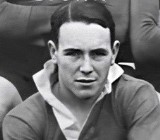
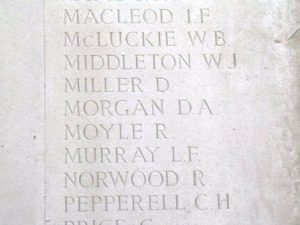
Percy Leslie Moxey, Pilot Officer, 121570, Royal Air Force Volunteer Reserve. Percy was born on 1 January 1915, the son of William Charles James Moxey and Lily Moxey (nee Williams), of 46, Queen Street, Pentre. He came to Llanelli to work as a Policeman prior to the war and in 1937 started playing at second row for Llanelli RFC. Percy was selected to play in several Welsh trials, before being offered the chance to play professional Rugby League and signed for Wigan in 1938. His parents, brothers and sisters had by now all moved to Great Yarmouth, and in the winter of 1941 Percy married Barbara Clare Reynolds there. Percy enlisted into the Royal Air Force Volunteer Reserve and became a regular in the RAF Rugby team. He trained as a Navigator before being posted to 16 Operational Training Unit, which was based at RAF Upper Heyford, and began training on bombers. On 7 August 1942 Percy took off from Upper Heyford aboard a Vickers Wellington IC, Serial R1075, on a night navigation exercise. The aircraft flew into a barrage balloon at Erdington, and crashed at Kingsbury Road, killing Percy and two other men. The remains of the 27-year-old were recovered from the wreck and he was brought back to Norfolk to be buried in Gorleston Cemetery, Great Yarmouth.
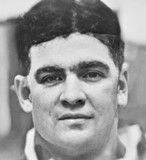
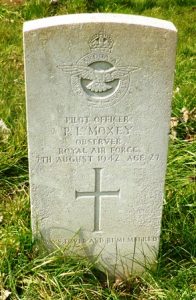
Some Former Scarlets Gallantry Award Winners – The Great War, 1914-1918
Below are details of some of the known Scarlets players who gained the award of gallantry medals during the war, but who survived and returned home. In the details of the fallen, two men gained gallantry awards and were killed, Major Harry Percy Bright Gough and William Henry Williams. Their details are both above.
Thomas Ballantine, MM, 84796, Corporal, Royal Engineers. Thomas was born in Hindlip, Worcestershire on 27 November 1888, the son of James Ballantine and Mary Ballantine (nee Hamilton). The family moved to Penyfai Farm, Llanelli by 1901. Thomas was educated at the Old Road School at Llanelli Intermediate School, before becoming a schoolteacher. He played rugby at forward for the Scarlets as a young man but had moved away by 1911 to become a schoolteacher at Great Yarmouth. He married Alice Marie Jay on 28 September 1914 and the couple then moved back to Llanelli, where their first child, a daughter, Marjorie Mary Ballantine, was born on 29 January 1916. Thomas then enlisted into the Royal Engineers and was promoted to Corporal. He was awarded the Military Medal for his bravery whilst serving on the Western Front during the winter of 1917. The award was published in the London Gazette of 22 February 1918. Thomas survived the war and moved with his family to York, where he died on 20 April 1971.
David Davies, DCM, Sergeant, 11866, Gloucestershire Regiment. David was from Llanelli and had been educated there at the National School. He had played rugby for the Scarlets and for Penygraig prior to the war. He enlisted into the 10th Battalion, Gloucestershire Regiment soon after the outbreak of war. The battalion formed at Bristol in September 1914, before joining the 26th Division on Salisbury Plain. In November 1914 the battalion moved to billets in Cheltenham, then in April 1915 moved back to Salisbury Plain. David landed in France with the battalion on 8 August 1915 and a week later the battalion joined 1 Brigade, 1st Division in the Loos Sector. The battalion enjoyed a brief spell behind the lines training at Ferfay, before moving into the front line on 23 September and on 25 September took part in the Battle of Loos, as one of the brigade’s assault battalions, where it succeeded in carrying the German front line at the cost of all but 60 of its men. The battalion then rebuilt, as did the remainder of the decimated 1st Division, over the coming months, before moving south to the Somme in June 1916. On 23 July 1916, during the Battle of Pozières, the battalion attacked the German line east of the village and was involved in two further attacks in the same area in August, all without success. The battalion’s last action of the war came on 9 September, in a failed attack on High Wood which cost it 122 casualties. David was awarded the Distinguished Conduct Medal for his gallantry during the early stage of the Somme offensive. The citation for the award was published in the London Gazette of 20 October 1916 and read: ‘For conspicuous gallantry. A very heavy and continuous barrage was put on our trenches, two officers and three men being buried, and the trench flattened for over 30 yards. He worked for over two hours in this barrage, assisting to dig out and rescue the buried men.’ In 1917, the 1st Division was allocated to Operation Hush and moved to the Flanders Coast to prepare for a possible offensive, but when the offensive was cancelled, as a result of the Passchendaele Offensive stalling in the mud, the 1st Division was moved to Ypres and took part in the final stages of the assault upon Passchendaele Ridge. The 10th Gloucester’s were disbanded in February 1918 and David was then posted to the 8th Battalion, Gloucestershire Regiment, taking part in the heavy fighting of 1918 and the final victory. He survived the war and was demobilised on 20 February 1919.
John Evans, MC, Lieutenant, 15th Battalion, Welsh Regiment. John was born on 25 December 1893, the son of David Evans and Hannah Evans (nee Morris), of Evel, Pembrey. He trained as a solicitor after leaving school and was articled to Alderman D. James Davies in Llanelli. John was a member of the Scarlet’s and played regularly for the Llanelli 2nd XV, as well as having made several appearances for the main Scarlet’s team and had scored a try against the visiting Springbok’s prior to the war. He was also a very able hockey player and had been a member of the Welsh rifle shooting team. He was commissioned Second Lieutenant into the 6th Battalion, Welsh Regiment on 3 April 1915, before being posted to the 15th Battalion, Welsh Regiment, the Carmarthen Pals. The battalion trained in North Wales as part of 129 Brigade, 43rd (Welsh) Division. The division trained in North Wales over the coming months, suffering from lack of arms and uniforms, then on 29 April 1915 became renumbered to the 38th (Welsh) Division. The division moved to Winchester in August 1915 to complete its training, before beginning to embark for France on 2 December, moving to the Nursery Sector at Fromelles for trench initiation and training. John came home on leave during the spring of 1916 and married Elizabeth Williams, the daughter of Alderman Joseph Williams. During June 1916 the Division marched south to the Somme, and on 7 July 1916 attacked Mametz Wood. The initial attack failed, and it was three days later, on 10 July, that a fresh attack was mounted. John was awarded the Military Cross for his famed gallantry during heavy fighting at The Hammerhead at Mametz Wood. The citation for the award was published in the London Gazette of 25 August 1916 and read: ‘For conspicuous gallantry during operations. He held on to a portion of a wood with great determination for several hours till relieved by another regiment.’ After two days of heavy hand to hand fighting within the wood, the Germans withdrew, and the battered Welshmen moved via Hébuterne to Boesinghe, on the Yser Canal, where it remained until launching its attack on Pilckem Ridge on 31 July 1917. The 15th Welsh remained in the line, and also took part in the Battle of Langemarck, before the entire Division was moved to positions near Armentieres over the winter. After the Germans launched their offensive on the Somme on 21 March 1918, the Division was moved back to the Somme, and took up positions north of Albert, around Aveluy Wood. On 21 August 1918 the division made a famous assault across the Ancre Valley, capturing Thiepval Ridge before taking part in the great advance to victory. John had been wounded twice during the war but had survived. After the Armistice John transferred to the 6th Welsh as part of the Army of Occupation in Germany, and on 21 July 1920 transferred to the 4th Welsh (TF). He became a prominent member of Llanelli society after the war and died in Llanelli on 18 June 1955.
William Hendy Evans, MM, Private, 20153, Welsh Regiment. Hendy was born in 1894, the son of Henry Evans and Elizabeth Evans, of 4, Cilheol, Llanelli. He was a Scarlets rugby star when he left Llanelli to become one of the original volunteers into the 15th Battalion, Welsh Regiment, the Carmarthen Pals. The battalion, formed from a nucleus of men from Carmarthenshire and Farnworth, moved to Rhyl to join 129 Brigade, 43rd (Welsh) Division. The division trained in North Wales over the coming months, suffering from lack of arms and uniforms, then on 29 April 1915 became renumbered to the 38th (Welsh) Division. The division moved to Winchester in August 1915 to complete its training, before beginning to embark for France on 2 December, moving to the Nursery Sector at Fromelles for trench initiation and training. On 2 December 1915 the battalion moved to France, and the entire Division moved to the Fleurbaix sector, where it was initiated into trench warfare. During June 1916 the Division marched south to the Somme, and on 7 July 1916 attacked Mametz Wood. The initial attack failed, and it was three days later, on 10 July, that a fresh attack was mounted. After two days of heavy hand to hand fighting within the wood, the Germans withdrew, and the battered Welshmen moved via Hébuterne to Boesinghe, on the Yser Canal. On the night of 29 April 1917, the 15th Welsh took part in a meticulously planned trench raid against the Mortjelde Estaminet, a renowned German strong point. The raid was an unqualified success but had cost the lives of a dozen men. William gained the award of the Military Medal for his bravery during the raid. The award was published in the London Gazette of 6 July 1917. The division remained in the same sector over the coming months until launching its attack on Pilckem Ridge on 31 July 1917. The 15th Welsh remained in the line, and also took part in the Battle of Langemarck, before the entire Division was moved to positions near Armentieres over the winter. After the Germans launched their offensive on the Somme on 21 March 1918, the Division was moved back to the Somme, and took up positions north of Albert, around Aveluy Wood. On 21 August 1918 the division made a famous assault across the Ancre Valley, capturing Thiepval Ridge before taking part in the great advance to victory. Hendy survived the war and was discharged from the army as medically unfit on 10 February 1919, due to gunshot wounds to his knee, but then played in two touring matches for the 38th (Welsh) Division against Neath and Swansea the following month!
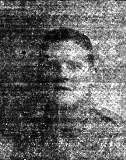
Edward Hughes, MM, Corporal, Royal Welsh Fusiliers. Edward, known as Ted, was a 21-year-old schoolteacher from North Wales who had come to Llanelli to teach at Lakefield School in 1914. He had played football at centre forward for Wrexham and Wolverhampton Wanderers, and after moving to Llanelli began playing football for the town. He was reported in several local newspaper to have been awarded the Military Medal during the winter of 1916. The reports stated: ‘A comrade writes: “He was awarded the Military Medal for fine work on a bombing strafe, knocking out a whole Fritz machine-gun crew. The boys tell me be deserved the D.C.M. at least.”’ He cannot be positively identified.
Hubert Edward John, Military Cross, Captain, 4th Battalion, Welsh Regiment. Hubert was born on 27 June 1887, the son of David John and Elizabeth John (nee Samuel), of 4, Twyn Row, Llanelli. He qualified as a solicitor in 1908. Hubert played at centre for the Scarlets for two seasons prior to the war and also played cricket for Llanelli. Hubert was commissioned as Second Lieutenant into the 4th Battalion, Welsh Regiment. The battalion was the local Territorial unit and mobilised for war at Carmarthen in August 1914, as part of South Wales Brigade, Welsh Division and moved to Tunbridge Wells until the end of the month, before moving to Scotland to man the Forth and Tay Defences. On 17 April 1915 the battalion moved to Bedford, joining 158 Brigade, 53rd (Welsh) Division. On 19 July 1915 the entire Division sailed from Devonport for Imbros and on 9 August 1915 landed at Suvla Bay. The infantry moved off the beaches across the Salt Lake, under shellfire, into the scrub covered Chocolate Hill, but due to a lack of maps and no knowledge of the terrain, many of the units became disorientated, and the situation became chaotic. The Division remained here throughout the coming months and suffered severe losses in manpower strength during the great November 1915 blizzard on Gallipoli, when its total strength was reduced to less than that of a full-strength Brigade. The Division was eventually evacuated from Gallipoli in December 1915, moving to Egypt to join the EEF, and helped guard the Suez Canal before taking part in operations to drive the Turks out of the Sinai. The EEF then turned its attention onto driving the Turks out of Palestine, and on 26 March 1917 launched its first offensive against the coastal city of Gaza, which guarded the road to Jerusalem. Initial gains during the day were lost when the assaulting divisions lost touch with each other, and communication broke down when a thick fog cloaked the battlefield. A second attempt to force Gaza was launched on 17 April, which also failed, and the EEF suffered a change in leadership, with Sir Edmund Allenby assuming command, before being re-organised, and a third offensive was launched against a wider front from Beersheba to Gaza on 31 October 1917. This time the Turkish defences were breached, and the road to Jerusalem now lay open and the EEF began to advance north. On 6 November 1917, 158 Brigade launched an attack on the Khuweilfeh Heights, and once secured, the EEF continued its advance into the Judean Hills, the 53rd Division capturing Hebron and Bethlehem, before securing the Jerusalem to Jericho Road. Allenby finally made his triumphant entry into Jerusalem on 11 December. Hubert was awarded the Military Cross for his actions during the Third Battle of Gaza. His award was published in the London Gazette of 16 August 1917. No citation has yet been traced. Hubert survived the war and returned to Llanelli, where he formed the 4th Welsh Old Comrades Association. He died in Llanelli on 29 September 1962.
Percy Edward Roberts, DCM, Private, 14226, 11th Battalion, Royal Welsh Fusiliers. Percy was born in 1894, the son of Edward John Roberts and Mary Ann Roberts, of 17, Biddulph Street, Llanelli. He worked as a tinplate worker prior to the war and was a regular player for the New Dock Stars rugby team, whilst his father had played rugby at full back for the Scarlets and for Wales. Percy was among the entire team from New Dock Stars who enlisted into the army on 7 September 1914, and was posted to the 11th Battalion, Royal Welsh Fusiliers. The battalion formed at Wrexham that month, before joining 67 Brigade, 22nd Division at Seaford. In December the battalion moved to St. Leonard’s in billets, then completed its training at Seaford and Aldershot before embarking for France and landed at Boulogne on 6 September 1915. The Division’s stay in France was to be very short, however, as on 27 October 1915 the Division, having been moved by train to Marseilles, began to embark for Salonika as part of an Anglo-French force sent to hold the Greek border, due to the invasion of neighbouring Serbia by a combined Austro-Hungarian force. The Division remained in the Salonika theatre for the rest of the war, taking part in the Retreat from Serbia during December 1915. Large battles were fought in August 1916, at the battle of Horseshoe Hill, then in September 1916 at the battle of Machukovo. Percy was awarded the Distinguished Conduct Medal for his gallantry during the battle. The citation for the award was published in the London Gazette of 24 November 1916 and read: ‘For conspicuous gallantry and devotion to duty. He carried a wounded man over a very exposed and rocky spur for a distance of 300 yards under a very heavy shell and rifle fire.’ The wounded man was David Hughes, of Brickyard Cottages, New Dock. The 22nd Division remained at Salonika for the remainder of the war and saw further fighting between 24 April and 9 May 1917 at the battle of Doiran, and then on 18 September 1918 at the Second Battle of Doiran. Following the Bulgarian surrender, the division began demobilisation at the beginning of 1919. Percy was demobilised on 15 April 1919 and upon his return to Llanelli was suffering from the effects of malaria. He recovered and lived until 17 February 1945, when he died at Llanelli.
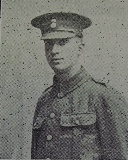
Gallantry Winners – World War Two, 1939-1945
William Harries Clement, MC, Captain (T/Major), 89525, 4th Battalion, Welch Regiment. (Llanelli). William played on the wing for Llanelli RFC from 1934 until the outbreak of war. He was commissioned into the 4th Battalion, Welch Regiment. He was recommended for the award of the Military Cross by Lieutenant Colonel Williams, whose report read: ‘On the night of 23 July 1944, two companies of the battalion took part in a raid on an enemy locality in the area of Le Bon Repos (Ref France 1/25,000 Sheet 37/16 S.E. Map Ref 944614). T/Major Clement was in command of the left forward company which had to advance down 900 yards of forward slope before reaching the objective. During this advance Major Clement was wounded in the left leg by shrapnel. Enemy opposition was considerable and the right forward platoon of Major Clements Company was, with the exception of four men, all either killed or wounded. In spite of his wound, Major Clement rallied his Company and pressed on to the final objective inflicting severe casualties on the enemy. Later when ordered to withdraw this officer remained behind and personally supervised the removal of his wounded before himself withdrawing. Major Clement had no second in command and only two young officers, one of which was killed with the right forward platoon; it was therefore entirely due to his devotion to duty and utter disregard to pain or personal danger that the object of the raid on the left flank was achieved, at least 30 enemy being killed in close quarter fighting. Major Clement remained with his company throughout the withdrawal and only agreed to receive treatment after returning to the Battalion RV.’ His award of the Military Cross was published in the London Gazette of 21 December 1944. Unfortunately he was wounded again during the advance through Holland, and these injuries during the war put an end to his rugby career.
